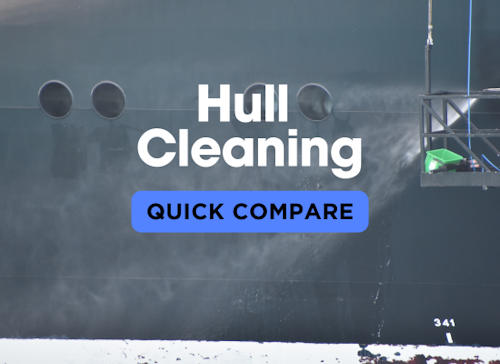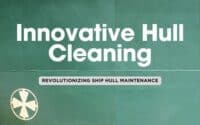Quick Compare: Ship Hull Cleaning Strategies

Regular hull cleaning not only improves fuel efficiency and speed but also extends the life of the vessel by preventing biofouling, which can cause corrosion and other damage. With a variety of hull cleaning strategies available, it’s essential for ship owners to choose the right method that balances cost, effectiveness, and environmental impact. In this quick guide, we’ll compare the top 10 hull cleaning strategies, providing a detailed overview of costs, pros, cons, and how long each method lasts. Whether you’re looking for a traditional approach or considering the latest technological advancements, we are here to help you make an informed decision.
| ShipUniverse: Example Costs and Downtime for Hull Cleaning Strategies (150m Cargo Ship) | ||||
|---|---|---|---|---|
| Strategy | Estimated Cost | Downtime | Frequency Required | Notes |
| Diver-Based Cleaning | $10,000 - $20,000 | 1-2 days | Every 3-6 months | Effective for spot cleaning; may not be suitable for severe fouling |
| Robotic Cleaning (ROVs) | $20,000 - $50,000 | 1 day | Every 3-6 months | Higher upfront costs, but minimal risk and consistent results |
| High-Pressure Water Blasting | $15,000 - $30,000 | 3-5 days (requires dry docking) | Every 6-12 months | Best combined with other maintenance activities |
| Abrasive Blasting | $30,000 - $60,000 | 5-7 days (requires dry docking) | Every 6-12 months | Highly effective; ideal before applying new coatings |
| Biocidal Antifouling Paint | $100,000 - $200,000 | 7-10 days (requires dry docking) | Every 1-2 years | Long-lasting protection; subject to environmental regulations |
| Fouling-Release Coatings | $150,000 - $300,000 | 7-10 days (requires dry docking) | Every 1-2 years | Eco-friendly, reduces drag and fuel consumption |
| Ultrasonic Antifouling | $20,000 - $40,000 | No additional downtime (installed during regular maintenance) | Continuous | Best for smaller vessels; limited effectiveness on heavy fouling |
| Electrolytic Antifouling | $50,000 - $100,000 | No additional downtime (installed during regular maintenance) | Continuous | Effective in saltwater; requires careful monitoring |
| In-Water Hull Cleaning Systems | $25,000 - $50,000 per cleaning | 1-2 days | Every 3-6 months | Reduces the need for dry docking; best for regular maintenance |
| Hybrid Cleaning Systems | $50,000 - $100,000 | Varies (may require dry docking) | Every 6-12 months | Combines multiple methods for comprehensive cleaning |
1. Diver-Based Cleaning
- Schedule During Off-Peak Times: Coordinate diver-based cleaning during off-peak periods or when the ship is docked for other reasons to minimize operational disruption.
- Focus on High-Impact Areas: Prioritize cleaning high-impact areas such as the bow and stern, where biofouling tends to accumulate most, to optimize fuel efficiency.
- Regular Inspections: Conduct frequent hull inspections to catch early stages of biofouling, reducing the need for intensive cleaning sessions.
2. Robotic Cleaning (ROVs)
- Integrate with Maintenance Schedule: Incorporate robotic cleaning into your regular maintenance schedule to maintain hull cleanliness without the need for dry docking.
- Monitor Performance Remotely: Use remote monitoring systems to oversee the performance of robotic cleaners, ensuring thorough cleaning without human intervention.
- Choose Versatile Robots: Opt for ROVs that can handle various hull shapes and materials, ensuring versatility across your fleet.
3. High-Pressure Water Blasting
- Combine with Coating Reapplication: Schedule water blasting when repainting or applying new antifouling coatings to maximize the longevity of both the hull and the coating.
- Use Recycled Water: Consider using recycled water for blasting to reduce environmental impact and comply with regulations.
- Prepare for Dry Docking: Ensure that your ship is prepared for dry docking, as this method requires the vessel to be out of the water, which may impact operational schedules.
4. Abrasive Blasting
- Pre-Inspect the Hull: Conduct a thorough inspection before abrasive blasting to identify any vulnerable areas that may require protection or special attention.
- Opt for Eco-Friendly Abrasives: Choose eco-friendly abrasive materials, such as glass beads or garnet, to reduce environmental harm and meet regulatory standards.
- Combine with Structural Repairs: Consider performing any necessary structural repairs during abrasive blasting, as the hull will be fully exposed and accessible.
5. Biocidal Antifouling Paint
- Choose the Right Biocide: Select a biocidal paint that is effective against the specific types of fouling common in the regions where your ships operate.
- Follow Application Guidelines: Ensure the paint is applied according to the manufacturer’s guidelines to achieve optimal coverage and durability.
- Monitor Environmental Compliance: Stay informed about environmental regulations regarding biocidal paints, as restrictions can change, affecting your ability to use certain products.
6. Fouling-Release Coatings
- Regular Hull Inspections: Perform regular inspections to identify areas where the coating may have worn off and reapply as necessary to maintain effectiveness.
- Optimize Speed and Route: Fouling-release coatings are most effective when ships maintain higher speeds. Plan routes and speeds that maximize the benefits of the coating.
- Train Crew on Maintenance: Train your crew on the specific maintenance requirements of fouling-release coatings to ensure they perform routine checks and touch-ups correctly.
7. Ultrasonic Antifouling
- Optimize Transducer Placement: Ensure transducers are strategically placed along the hull to provide comprehensive coverage and maximize the effectiveness of the ultrasonic waves.
- Combine with Other Methods: Use ultrasonic antifouling as a complementary solution with other cleaning strategies for larger vessels or those operating in highly fouling-prone areas.
- Regular System Checks: Schedule regular maintenance checks to ensure the ultrasonic system is functioning correctly and providing continuous protection.
8. Electrolytic Antifouling
- Use with Metal Hulls: This method is most effective on metal hulls, especially in saltwater environments where electrolytic processes work best.
- Monitor System Performance: Regularly monitor the system’s performance to ensure it’s effectively preventing biofouling without causing corrosion or other issues.
- Consider Water Chemistry: Adjust the system based on local water chemistry, as factors like salinity and temperature can impact the effectiveness of electrolytic antifouling.
9. In-Water Hull Cleaning Systems
- Schedule Between Voyages: Plan in-water cleaning sessions between voyages to minimize operational downtime and maintain optimal hull performance.
- Use Eco-Friendly Brushes: Opt for eco-friendly brushes or pads that minimize damage to the hull coating while effectively removing biofouling.
- Monitor Cleaning Frequency: Track how quickly biofouling reoccurs after cleaning to optimize the frequency of in-water cleaning sessions, balancing cost and effectiveness.
10. Hybrid Cleaning Systems
- Tailor the Approach: Customize the cleaning approach based on the type of fouling and the specific needs of each vessel, using a combination of methods for the best results.
- Train Specialized Operators: Ensure that operators are well-trained in using hybrid systems, as these methods may require a high level of skill and understanding of different techniques.
- Document Results: Keep detailed records of the effectiveness of each component of the hybrid system to refine and improve the approach over time.
| ShipUniverse: Quick Compare - The Top 10 Hull Cleaning Strategies | |||||
|---|---|---|---|---|---|
| Strategy | Cost | Pros | Cons | How Long It Lasts | Best For |
| Diver-Based Cleaning | Moderate | - Precision cleaning - Suitable for hard-to-reach areas |
- Time-consuming - Risk to divers |
3-6 months | All ship types, especially with complex hull designs |
| Robotic Cleaning (ROVs) | High | - No human risk - Consistent results |
- High upfront cost - Requires specialized equipment |
3-6 months | All ship types, particularly large vessels |
| High-Pressure Water Blasting | Moderate | - Effective for tough fouling - No chemicals required |
- Requires dry docking - High water usage |
6-12 months | Large vessels with heavy fouling |
| Abrasive Blasting | High | - Removes old paint and fouling - Prepares surface for new coatings |
- Environmental concerns - Can damage hull if not done properly |
6-12 months | Ships undergoing repainting or major maintenance |
| Biocidal Antifouling Paint | Moderate to High | - Long-lasting - Proven effectiveness |
- Environmental regulations - Potential toxicity |
1-2 years | All ship types in biofouling-prone areas |
| Fouling-Release Coatings | High | - Eco-friendly - Reduces drag |
- Higher cost - May require more frequent touch-ups |
1-2 years | Eco-conscious operators |
| Ultrasonic Antifouling | High | - No chemicals - Continuous protection |
- High initial cost - Limited effectiveness on larger fouling |
1-2 years | Smaller commercial vessels, yachts |
| Electrolytic Antifouling | Moderate to High | - Continuous protection - Low maintenance |
- Complex installation - Limited to specific hull materials |
1-3 years | Ships with metal hulls, especially in saltwater |
| In-Water Hull Cleaning Systems | High | - No dry dock needed - Reduces downtime |
- Requires specialized equipment - May not be as thorough |
3-6 months | All ship types, especially those with tight schedules |
| Hybrid Cleaning Systems | High | - Combines multiple methods - Adaptable to different fouling levels |
- High cost - Requires skilled operators |
6-12 months | Large, high-value vessels |

Do you have a Maritime Product or Service that may be of interest to Shipowners? Tell us about it here!
Do you have feedback or insights? Please reach out to editor @ shipuniverse.com


